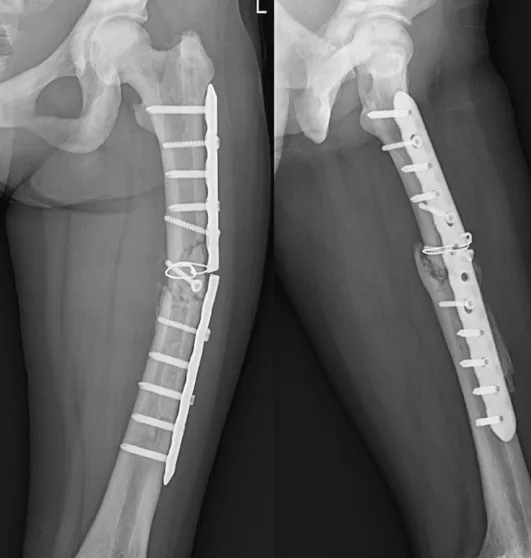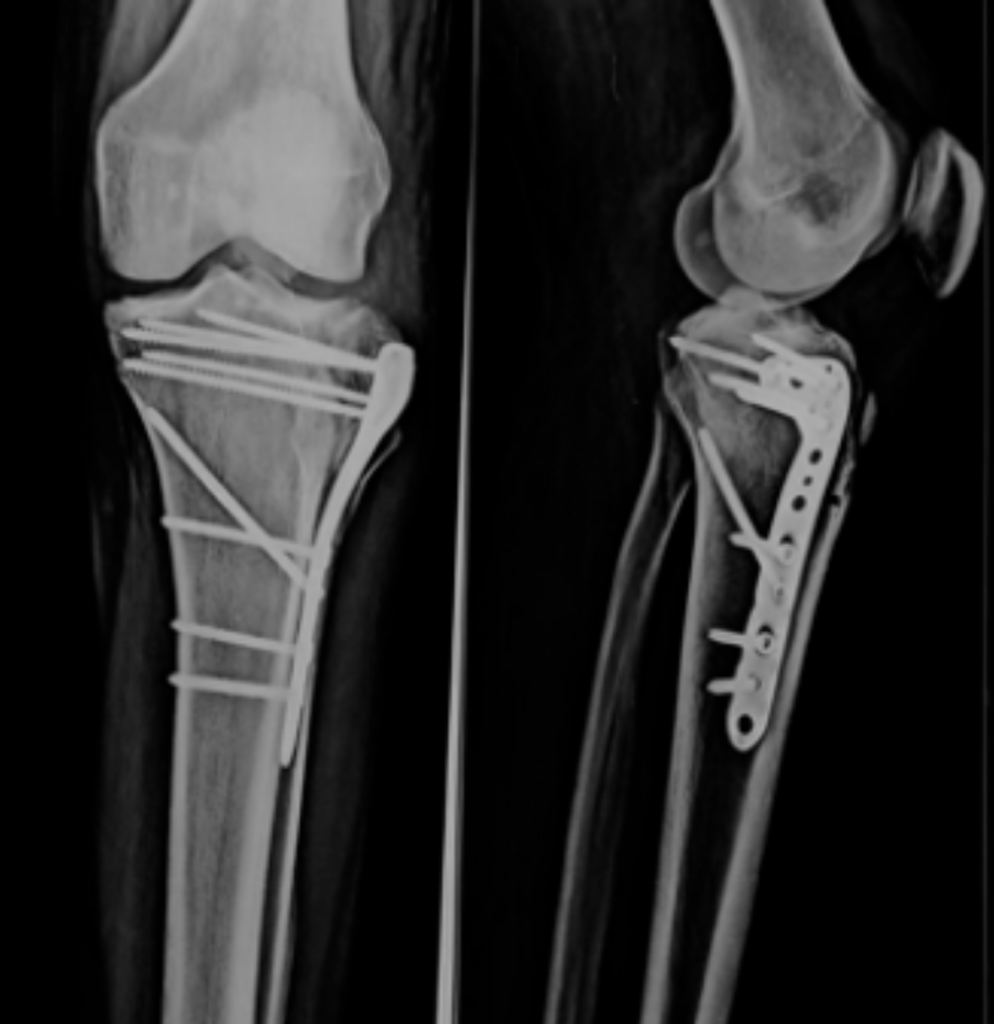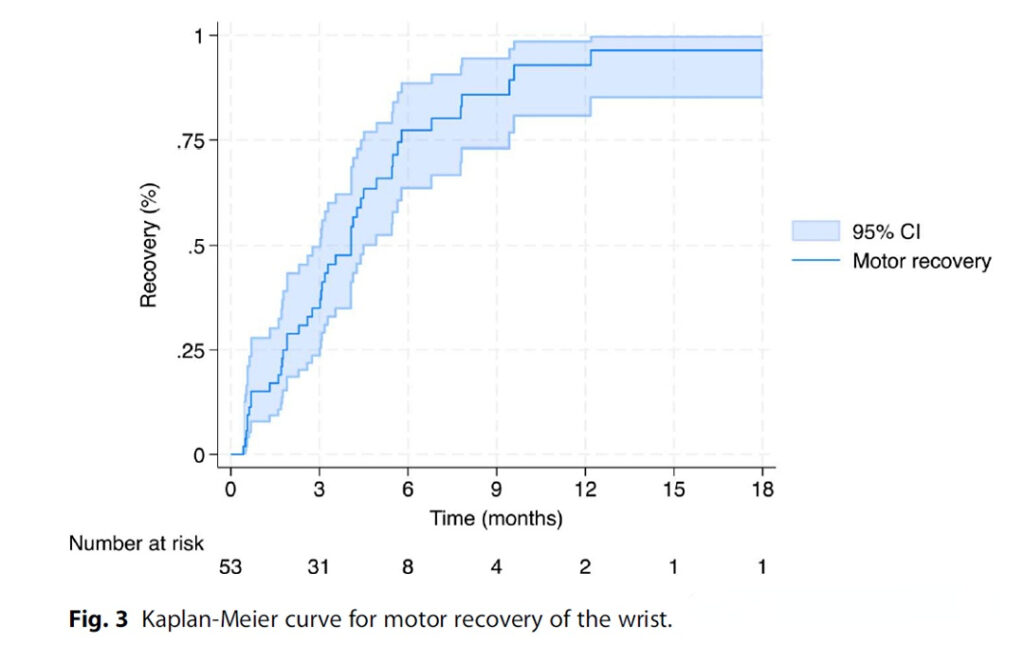Today, let’s delve deeper into the causes and preventative measures for internal fixation failure in femoral shaft fractures:

1. Patient Factors:
- Detailed Causes:
- Metabolic Disorders (Diabetes): Compromised blood sugar control hinders osteoblast function, reduces bone formation, and increases infection risk, weakening fixation.
- Immunosuppression: Predisposes to infection and delays bone healing. Medications like corticosteroids directly inhibit osteoblast activity and bone remodeling.
- Smoking: Nicotine constricts blood vessels, reducing blood flow to the fracture site. This impairs oxygen and nutrient delivery crucial for healing, increasing non-union risk.
- Osteoporosis: Characterized by low bone density, osteoporosis weakens bone stock, making it less able to withstand mechanical stress, increasing implant loosening and failure risk.
- Higher BMI and Activity Level: Increased body weight and dynamic loading place higher stress on the implant, potentially exceeding its fatigue limit and leading to breakage.
- Prevention Strategies:
- Optimize Comorbidities: Pre-operative management of diabetes, smoking cessation programs, and addressing nutritional deficiencies are crucial.
- Bone Health Assessment: Screen for osteoporosis and consider pre-operative treatment (bisphosphonates) to improve bone density before surgery.
- Patient Education: Thoroughly explain weight-bearing restrictions and activity modifications based on individual healing progress and risk factors.
2. Cerclage Wire Use:2.
- Detailed Causes:
- Disrupting Callus Formation: Placing wires at the fracture line disrupts the natural process of callus formation, a critical step in bone healing. Wires act as a barrier, preventing the bridging of the fracture gap.
- Compromising Blood Supply: Multiple closely spaced wires constrict blood vessels surrounding the fracture. This reduces the oxygen and nutrient supply essential for bone healing, leading to delayed union or non-union.
- Prevention Strategies:
- Strategic Placement: Avoid placing cerclage wires directly at the fracture site, especially in simple fractures where alternative fixation methods suffice.
- Minimizing Wire Number: Use the minimum number of wires necessary to achieve stability. Explore other fixation options (intramedullary nails, plates) in complex fractures.
3. Cerclage Wire Placement:
- Detailed Causes:
- Arterial Injury: Inadvertent placement around the circumflex femoral artery can lead to acute occlusion, compromising blood supply to the femoral head and neck, potentially resulting in avascular necrosis.
- Nerve Damage: Incorrect wire positioning can injure nearby nerves (e.g., sciatic nerve, lateral femoral cutaneous nerve), leading to pain, numbness, weakness, or paralysis.
- Prevention Strategies:
- Anatomical Knowledge: A precise understanding of regional anatomy is essential. Surgeons must carefully identify and protect critical neurovascular structures during surgery.
- Image Guidance: Intraoperative fluoroscopy is crucial for visualizing wire placement about surrounding anatomy, minimizing the risk of injury.
4. Screw Placement in Intramedullary Nailing (IMF):
- Detailed Causes:
- Lag Screw Vulnerability: The proximal screw hole, often used for lag screw fixation, represents a stress concentrator in the nail. Incorrectly placed screws at this point significantly increase the risk of nail breakage.
- Off-Axis Drilling: If the screw hole is drilled at an angle or off-center, it weakens the nail and creates stress points, making it more susceptible to fatigue failure under load.
- Prevention Strategies:
- Precise Drilling: Meticulous surgical technique and image guidance (fluoroscopy) are vital for ensuring accurate screw hole placement and avoiding nail weakening.
- Choosing Appropriate Screws: Screw length and diameter must be carefully selected based on patient anatomy and bone quality. Oversized screws further weaken the nail.
5. Screw Placement in Plate Osteosynthesis (PO):
- Detailed Causes:
- Stress Risers: Each screw hole acts as a stress riser in the plate, concentrating forces at these points. Filling every hole significantly weakens the plate and increases the likelihood of breakage, especially near the fracture site.
- Interference with Callus: Placing screws directly within the fracture line disrupts callus formation by inhibiting bone-to-bone contact and bridging the fracture gap.
- Prevention Strategies:
- Strategic Screw Placement: Utilize a limited number of screws to provide adequate stability. Space them strategically along the plate, avoiding over-crowding near the fracture site.
- Respecting Fracture Biology: Avoid placing screws directly within the fracture line to allow for unobstructed callus formation and bridging.
6. Choice of Implant and Fixation:
- Detailed Causes:
- Underestimation of Load: Selecting an implant with insufficient strength (e.g., too thin a nail, inadequate plate size) for the patient’s weight, activity level, and fracture pattern will likely lead to failure under physiological loads.
- Inappropriate Fixation: Using a fixation method not suited to the fracture pattern can result in inadequate stability and increased stress on the implant. For example, a transverse fracture treated with a single lag screw without additional fixation might experience excessive shearing forces, leading to failure.
- Prevention Strategies:
- Thorough Pre-operative Planning: Carefully assess fracture type, location, complexity, patient factors, and functional demands. Consider expected loads and choose implants that provide adequate strength and stability.
- Following Established Guidelines: Adhering to AO principles and established surgical guidelines for specific fracture patterns helps ensure appropriate fixation techniques are employed.
7. Technical Errors During Surgery:
- Detailed Causes:
- Inadequate Reduction: Failure to achieve anatomical reduction can lead to uneven force distribution across the fracture site, placing excessive stress on the implant and increasing the risk of loosening or breakage.
- Periosteal Damage: Excessive stripping of the periosteum, which provides blood supply and contributes to bone healing, can impair fracture healing and compromise implant stability.
- Prevention Strategies:
- Gentle Tissue Handling: Minimize periosteal stripping during surgery. Employ minimally invasive techniques when possible to preserve blood supply and promote healing.
- Intraoperative Imaging: Utilize fluoroscopy to confirm accurate anatomical reduction and guide implant placement, ensuring optimal stability and load distribution.
8. Infection:
- Detailed Causes:
- Osteolysis and Implant Loosening: Infection triggers an inflammatory response that leads to bone resorption (osteolysis) around the implant. This weakens the bone-implant interface, increasing the risk of loosening and failure.
- Impaired Bone Healing: Infection disrupts the normal cascade of bone healing, reducing callus formation and increasing the likelihood of non-union. This prolonged instability further challenges implant integrity.
- Prevention Strategies:
- Strict Asepsis: Adhere to stringent sterile techniques throughout the surgical procedure to minimize the risk of contamination.
- Prophylactic Antibiotics: Administer pre-operative antibiotics and consider continuing them post-operatively, especially in open fractures or cases with higher infection risk.
9. Inadequate Fracture Stabilization:
- Detailed Causes:
- Implant Micromotion: Excessive movement at the fracture site, even at a microscopic level, can prevent the formation of a stable callus bridge. This continuous instability can lead to implant fatigue and failure over time.
- Delayed Union or Non-Union: Prolonged healing times or complete failure of the fracture to heal increases the duration and magnitude of stress on the implant, increasing the likelihood of failure.
- Prevention Strategies:
- Achieving Absolute Stability (When Indicated): For specific fracture patterns where absolute stability is crucial for healing, ensure adequate compression and rigid fixation to minimize micromotion.
- Biological Augmentation: In complex cases or those with compromised healing potential, consider adjunctive therapies like bone grafting, growth factors, or bone marrow aspirate to stimulate bone formation and enhance stability.
10. Mechanical Overload:
- Detailed Causes:
- Implant Fatigue: Repetitive cyclic loading, especially beyond the implant’s intended capacity, leads to microscopic cracks in the metal. Over time, these cracks propagate and eventually lead to fatigue failure.
- Sudden Impact: High-energy impacts or falls can generate forces exceeding the implant’s ultimate tensile strength, causing immediate breakage or catastrophic failure.
- Prevention Strategies:
- Gradual Return to Activity: Implement a staged rehabilitation program that gradually increases weight-bearing and activity levels, allowing the bone and implant to adapt to progressively higher loads.
- Fall Prevention: Educate patients, particularly the elderly or those with balance issues, on fall prevention strategies to minimize the risk of sudden impacts on the healing fracture.
By meticulously addressing these ten aspects, surgeons can significantly reduce the occurrence of internal fixation failure in femoral shaft fractures. A thorough understanding of the underlying causes, combined with careful surgical planning, precise technique, and comprehensive patient management, is vital for achieving optimal outcomes and improving patient lives.
Disclaimer:
This article and all articles on this website are for reference only by medical professionals; specific medical problems should be treated promptly. To ensure “originality” and improve delivery efficiency, some articles on this website are AI-generated and machine-translated, which may be inappropriate or even wrong. Please refer to the original English text or leave a message if necessary. Copyright belongs to the original author. If your rights are violated, please contact the backstage to delete them. If you have any questions, please leave a message through the backstage, or leave a message below this article. Thank you!
Like and share, your hands will be left with the fragrance!




